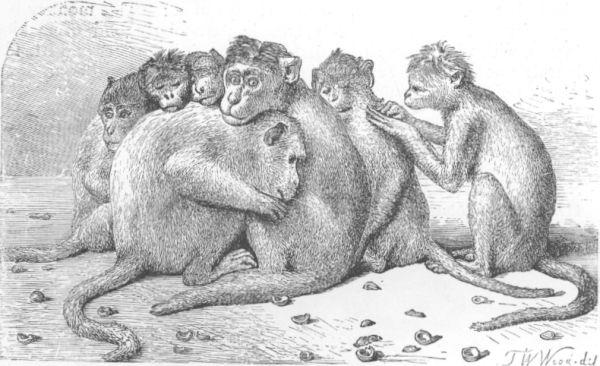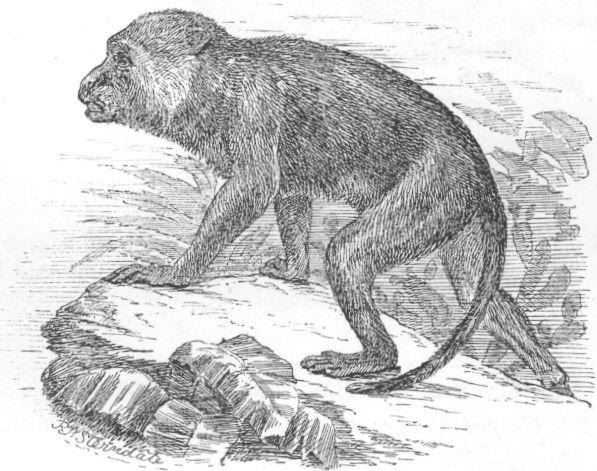| Page 11 | |
|
Natural History of the Mammalia of India and Ceylon - by Robert A. Sterndale F.R.G.S., F.Z.S. (1884) | |
| prev page next page | contents |
GENUS MACACUS.
Tail longer than in Inuus, and face not so lengthened; otherwise as in that genus.—Jerdon.
24. MACACUS RADIATUS. The Madras Monkey (Jerdon's No. 9).
NATIVE NAMES.—Bandar, Hindi; Makadu or Wanur, Mahratti; Kerda mahr of the Ghâts; Munga, Canarese; Koti, Telegu; Vella munthi, Malabar.
HABITAT.—All over the southern parts of India, as far north as lat. 18°.

Macacus radiatus and Macacus pileatus.
DESCRIPTION.—Of a dusky olive brown, paler and whitish underneath, ashy on outer
sides of limbs; tail dusky brown above, whitish beneath; hairs on the crown of the head radiated.
SIZE.—Twenty inches; tail 15 inches.
Elliott remarks of this monkey that it inhabits not only the wildest jungles, but the most populous towns, and it is noted for its audacity in stealing fruit and grain from shops. Jerdon says: "It is the monkey most commonly found in menageries, and led about to show various tricks and feats of agility. It is certainly the most inquisitive and mischievous of its tribe, and its powers of mimicry are surpassed by none." It may be taught to turn a wheel regularly; it smokes tobacco without inconvenience.—Horsfield.
25. MACACUS PILEATUS (vel SINICUS, Lin.).
The Capped Monkey, or Bonneted Macaque of Cuvier.
NATIVE NAME.—Rilawa, Singhalese.
HABITAT.—Ceylon and China.
DESCRIPTION.—Yellowish brown, with a slight shade of green in old specimens; in some the back is light chestnut brown; yellowish brown hairs on the crown of the head, radiating from the centre to the circumference; face flesh-coloured and beardless; ears, palms, soles, fingers, and toes blackish; irides reddish brown; callosities flesh-coloured; tail longish, terminating in short tuft.—Kellaart.
SIZE.—Head and body about 20 inches; tail 18 inches.
This is the Macacus sinicus of Cuvier, and is very similar to the last species. In Ceylon it takes the place of our rhesus monkey with the conjurors, who, according to Sir Emerson Tennent, "teach it to dance, and in their wanderings carry it from village to village, clad in a grotesque dress, to exhibit its lively performances." It also, like the last, smokes tobacco; and one that belonged to the captain of a tug steamer, in which I once went down from Calcutta to the Sandheads, not only smoked, but chewed tobacco. Kellaart says of it: "This monkey is a lively, spirited animal, but easily tamed; particularly fond of making grimaces, with which it invariably welcomes its master and friends. It is truly astonishing to see the large quantity of food it will cram down its cheek pouches for future mastication."
26. MACACUS CYNOMOLGUS. The Crab-eating Macaque.
NATIVE NAME.—Kra, Malay.
HABITAT.—Tenasserim, Nicobars, Malay Archipelago.

Macacus cynomolgus.
DESCRIPTION.—"The leading features of this animal are its massive form, its
large head closely set on the shoulders, its stout and rather short legs, its
slender loins and heavy buttocks, its tail thick at the base" (Anderson). The
general colour is similar to that of the Bengal rhesus monkey, but the skin of
the chest and belly is bluish, the face livid, with a white area between the eyes and white eyelids. Hands and feet blackish.
SIZE.—About that of the Bengal rhesus.
According to Captain (now Sir Arthur) Phayre "these monkeys frequent the banks of salt-water creeks and devour shell-fish. In the cheek-pouch of the female were found the claws and body of a crab. There is not much on record concerning the habits of this monkey in its wild state beyond what is stated concerning its partiality for crabs, which can also, I believe, be said of the rhesus in the Bengal Sunderbunds."
27. MACACUS CARBONARIUS. The Black-faced Crab-eating Monkey.
HABITAT.—Burmah.
DESCRIPTION.—In all respects the same as the last, except that its face is blackish, with conspicuously white eyelids.
